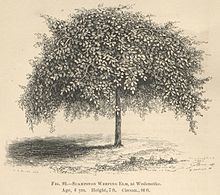Cultivar 'Scampstoniensis' | Origin England | |
 | ||
People also search for Ulmus minor 'Cucullata' | ||
The elm cultivar Ulmus 'Scampstoniensis', the Scampston Elm or Scampston Weeping Elm, is said to have come from Scampston Hall, Yorkshire, England, before 1810. Loudon opined that a tree of the same name at the Royal Horticultural Society's Garden in 1834, 18 feet (5.5 m) high at 8 years old "differed little from the species" (i.e. the smooth-leaved elm, his U. glabra [:Ulmus minor ]). Henry described the tree, from a specimen growing in Victoria Park, Bath, as "a weeping form of U. nitens" [:Ulmus minor ]; however Green considered it "probably a form of Ulmus × hollandica". Writing in 1831, Loudon said that the tree was supposed to have originated in America. U. minor is not, however, an American species, so if the tree was brought from America, it must originally have been taken there from Europe. There was (and is) an 'American Plantation' (or 'America Plantation') at Scampston, which may be related to this supposition. A number of old specimens of 'Scampstoniensis' in this plantation were blown down in a great gale of October 1881; younger specimens were still present at Scampston in 1911.
Contents
Georg Dieck of the National Arboretum in Zöschen, Germany, considered 'Scampstoniensis' a synonym of Ulmus scabra Serpentina [see U. × hollandica 'Serpentina' ], a view rejected by Petzold, who in his Arboretum Muscaviense listed 'Scampstoniensis' separately, and by the Hortus Botanicus Leiden, which had a specimen of 'Scampstoniensis' (see below). "From the Travemünder Nurseries we received an U. scampstoniensis, an elm with a beautiful pendulous shape," wrote Petzold, "that we distinguish from our U. montana Pendula."
Description
'Scampstoniensis' was said to droop its branches very distinctly and regularly, giving the tree a symmetrical form, as though it had been regularly trained and trimmed, unlike 'Camperdownii', which had less of a tendency to regular drooping, and with less abundant foliage. A 1911 article in 'Historical Notes of Rillington and Scampston' described 'Scampstoniensis' as "remarkable for its size when mature, for its spreading habit, and its rough corky bark".
Pests and diseases
A specimen at the Ryston Hall, Norfolk, arboretum, obtained from the Späth nursery in Berlin, was killed by the earlier strain of Dutch elm disease prevalent in the 1930s.
Cultivation
Loudon described the Scampston Elm, in a letter of 1836 to the Newcastle Courant, as "generally understood to have been extensively planted in Northumberland about 80 years ago". The Scampston Elm was in cultivation on both sides of the Atlantic in the 19th century and was occasionally referred to as Ulmus americana pendula. The American horticulturalist Frank Jesup Scott in The Art of Beautifying Suburban Home Grounds of Small Extent (1870) described how two 'Scampston elms' could be pruned and trained to form an archway of weeping elm. One tree was planted in 1896 as U. glabra scampstoniensis at the Dominion Arboretum, Ottowa, Canada. A specimen of 'Scampstoniensis' existed opposite the Botanic Garden, Bath in 1902, where it was listed as U. montana Glabra [:'smooth'(-leaved)] microphylla pendula. Three specimens supplied by the Späth nursery of Berlin to the Royal Botanic Garden Edinburgh in 1902 as U. glabra [:'smooth'(-leaved)] Scampstoniensis may survive in Edinburgh, as it was the practice of the Garden to distribute trees about the city (viz. the Wentworth Elm). Elwes saw the decayed stump of the original tree at Scampston Hall, by which time (1913) the tree was no longer known to be in cultivation in nurseries in England. 'Scampstoniensis' continued to be distributed by the Späth nursery into the 1930s.
Possibly only two specimens now survive, as grafted trees, in Brighton, England; see 'Notable trees' below.
Notable trees
A weeping elm in the Hortus Botanicus Leiden was described there by the curator in 1890 in a Sempervirens article as an Ulmus americana Pendula, one of the synonyms of 'Scampstoniensis'. It was carefully distinguished by him from two forms of weeping wych elm nearby, and was said to produce, in addition, vigorous ascending branches that needed regular pruning to maintain a tidy weeping shape. Three weeping elms were later photographed in the Hortus c.1920, two of them forms of weeping wych, the third a semi-weeping elm with smaller leaves and numerous long shoots, many ascending, that appears at one time to have been pruned: by process of elimination, the Ulmus americana Pendula ('Scampstoniensis') of the 1890 Sempervirens article. The c.1920 tree, though mature, closely resembles the 1859 illustration of a young 'Scampstoniensis' in New York. The 1890 article had expressed doubts about the name Ulmus americana Pendula; the c.1920 photograph labels the tree U. scabra [our U. glabra] pendula, despite its differences from the two weeping wych clones. The herbarium of the Naturalis Biodiversity Center in Leiden holds leaf specimens labelled "U. carpinifolia 'Pendula' (formerly called U. glabra Hudson 'Scampstoniensis')", from a tree in the Wageningen Arboretum.
The possible UK TROBI Champions grow in Woodvale Cemetery, Brighton, perhaps planted in 1851; two grafted trees, survivors of some ten c.1980, measuring 26 m high by 73 cm d.b.h., and 22 m by 70 cm, in 2002. One of the two lost half its crown in a storm of 2016. Their leaves are a good match for herbarium leaf-specimens of 'Scampstoniensis' (Späth) held in the RBGE, and their prolific long shoots match those of the Leiden tree. The cultivar does not, however, feature in the list of accessions of the National Elm Collection held by Brighton & Hove City Council
